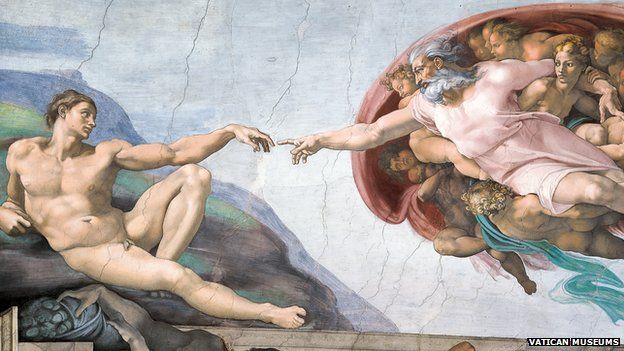

Sistine Chapel ceiling and altar wall frescoes, Vatican City, Italy. Michelangelo. Ceiling frescoes: c. 1508-1512 C.E.; altar frescoes: c. 1536-1541 C.E. Fresco
The paintings depict nine stories from the Christian Bible's Book of Genesis, including the most famous image, the Creation of Adam (right). Taken together, the paintings are considered one of the world's greatest art masterpieces. Their realistic and extremely detailed depictions of some of Judaism's and Christianity's most famous moments are a wonder to all who see them.
- every surface--ceilings, floors--are covered in mosaic and fresco
- where the College of Cardinals decides who the next pope will be
- ceiling vault completely covered in fresco
- 9 Old Testament scenes separated by painted architecture
- Michelangelo began work on the frescoes in 1508 for Pope Julian
- he continued work on it for 4 years, but took a break in 1510, and the frescoes painted after this time are palpably different--compare the complex narrative of The Deluge, which uses smaller figures, to the more idealized, monumental figures in God creates Adam
- the vault frescos are undeniably some of the most important images every painted--they turned into an "academy" for painters, meaning that up and coming Renaissance artists would visit the chapel in order to try to study and imitate the monumental weight, harmony, strength, anatomical perfection, and elegance of Michelangelo's figures
- the chapel has recently undergone a controversial cleaning in which soot and grime from years of the chapel's use were cleaned off to try to bring back the rich colors of Michelangelo's vision
- revolutionary painting style where the figures were so realistic that they looked like sculptures
- brilliant, rich colors were used
- Michelangelo's style involved "carving figures out of paint"
- figures are massive; have gravity, weight and presence
- are figures of idealized beauty (shows the relative religious optimism of the time; as compared to when Michelangelo paints The Last Judgement above the altar and his style has become more cynical and Mannerist)
- emphasized musculature and anatomy
- anatomy displays drama and power (despite the fact that that many of them are in positions of relative peace--for ex. Libyan Sybil)
- a complex "stage" of connected yet separate scenes
- strong visible presence of Ancient Roman and Greek sculptural style
- no images of Christ, but the scenes lay the stage for the coming of Christ
- the richly colored, monumental figures help convey the emotional impact of the scenes to the viewers gazing up at them from the floor
- Layout:
- 9 biblical scenes from Genesis that move across the ceiling lengthwise (starts with God dividing light from dark and moves on chronologically)
- 1. Noah is drunk and disgraced
- 2. The Great Flood/Deluge
- 3. Noah and his family make a sacrifice after the flood
- 4. Adam and Eve are tempted + sent from Eden
- 5. God creates Eve
- 6. God creates Adam
- 7. God divides the water from the Earth
- 8. God creates the sun and planets
- 9. God divides light from darkness
- scenes are framed by a painted architectural framework
- scenes are flanked on both sides by prophets and sybils that sit within the painted architecture in the spandrels, separate from the depicted scenes but connected ideologically
- sybils: pagan soothsayers that foretold the coming of Christ
- sitting on the architectural framework of the four architectural corners of each nine biblical scenes are male nude figures, called ignudi
- scenes from the Salvation of Israel painted in the pendentives
- the sibyls were said to be future-seers of pagan times who saw the coming of Christ
- validates the Christian faith because the coming of Christ was foretold long before Jesus was even born
- shows a theme of foretelling present in Christian artwork since the Middle Ages; sibyls foretold the coming of Christ, the Old Testament foretold the coming of the New Testament, Mary foretold the death of her son
- her body has a circular composition
- signifies grace, balance, and harmony of proportion
- she has a "sculptural weight"--looks as though she is actually coming out of the walls due to the painted contour (contrapposto) of her skin and muscle
- she has idealized anatomy--by the way her muscles are sculpted, she looks as though she has incredible strength, yet she also possesses a sense of calm elegance (sprezzatura: a deceptive ease)
- shows close attention to human anatomy
- some believe that she was modeled after a man (which makes sense looking at the prominent muscles in her arms)--"biblical" beauty instead of sexual, like in Botticelli's Venus
- painted after Michelangelo took his break in 1510, so they show his new style of monumentality
- some believe that all the sibyls are modeled after the ancient sculpture the Belvedere Torso (see below)
Form
Highly modeled figures
Facial expressions and dynamic poses reveal the sadness and desperation depicted in the scene
Figures interact with each other
Many hold each other in their arms or on their backs
Some figures reach for each other or joste past one another
Function
Makes viewers question God’s justice → why would he destroy the whole population of
Earth, spare Noah and his family?
Content
Physical space of the water and sky separate the 4 parts of the narrative
On the right: a group of people find makeshift shelter from the rain
On the left: people scale a mountain to escape floodwaters
Central: A small boat teeters, about to capsize due to the rising waters
Background: men work to build the ark
Full of figures → makes the event seem chaotic, large-scale; but also waters down (pun not intended) the emotional intensity of the narrative from a distance








